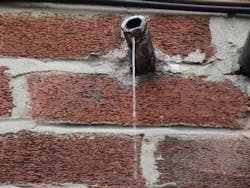Wisconsin DNR to aid replacement of lead service lines
SOURCE: Wisconcin DNR
MADISON, WI, April 27, 2016 -- In a major effort to clear the way for cleaner water from the tap, the Wisconsin Department of Natural Resources plans to make $11.8 million available to municipalities to help remove old lead service lines that bring drinking water into homes.
The move, coming in advance of National Drinking Water Week, May 1 -7, underscores DNR's commitment to safe drinking water and addresses the financial barriers facing many communities where lead service lines continue to deliver drinking water to residences. These service lines extend from the main street pipes owned by local utilities onto private property and into homes.
Lead service lines were gradually phased out of new construction during the 1940s and '50s but remain in some areas developed before that time. Lead service lines may deliver drinking water with elevated lead levels at the tap and even low levels of lead in blood have been shown to affect IQ, ability to pay attention and academic achievement.
"Clean, safe drinking water is fundamental to the health of our communities," said DNR Secretary Cathy Stepp. "Through this innovative effort, we are pleased to be able to support the efforts of private citizens and municipalities around the state to remove these old lead service lines."
To create the program, DNR is taking advantage of a recent decision by the U.S. Environmental Protection Agency that allows greater flexibility in allocating federally funded loans for water infrastructure projects. Through the state's Safe Drinking Water Loan Program, DNR now has the ability to provide disadvantaged municipalities with funding to help cover the costs of lead service line replacements on private property.
Typically, homeowners are responsible for repair and replacement of service lines extending from the public right of way across their property and into the residence. Municipal water utilities bear responsibility for replacing the main lines.
Many homeowners are unable to afford complete replacement of lead service lines, which can range in price but averages about $3,000 per home. Despite the cost, full replacement is recommended because a partial replacement can increase the amount of lead being released into the water.
"DNR recognizes the challenges many communities face in addressing the issue of lead service lines and the Safe Drinking Water Loan Program offers an effective way to fill the financial gap," Stepp said. "We're grateful to EPA for the flexibility that allows us to move forward. Following the required public comment period and approvals, we anticipate making these funds available for projects starting July 1, 2016."
Disadvantaged municipalities are determined based on factors including population and median household income. Under this proposal, municipalities with a population of less than 50,000 will be eligible for up to $300,000 for lead service line replacement costs on private property. For medium-sized communities, that cap will be $500,000, and for the largest municipalities - those with a population greater than 500,000 - the cap will be $750,000.
Under the program, communities would determine how to distribute the funds to homeowners. If providing full funding for replacement at an average cost of $3,000 per household, smaller municipalities could replace approximately 100 lead service lines, larger communities more than 166 lines and the largest municipalities more than 250 lead service lines. If the program proves successful, DNR would seek to provide a similar level of funding for the fiscal year starting July 1, 2017.
Municipalities will need to comply with the Safe Drinking Water Loan Program requirements and with federal regulations including Use of American Iron and Steel and Davis-Bacon wage requirements. Money for the lead service line replacement program does not represent new tax revenue; instead it represents new flexibility to allocate existing funds following a determination by U.S. EPA in March.
To learn more about the Safe Drinking Water Loan Program Intended Use Plan, visit the DNR website, dnr.wi.gov, and search "environmental loans."
